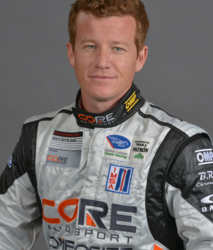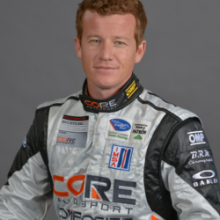Ask a pro
Receive advice directly from today’s top stars
American sports car star Patrick Long takes over the reigns as the latest Online Driving Instructor. An official Porsche factory driver since 2003, Long can count two GT class victories at the Le Mans 24 Hours race among his list of accomplishments which also include 21 race wins and three championships in American Le Mans Series competition. In recent years he has been instrumental in providing opportunities for several other talented young North American drivers to follow in his footsteps. Post your questions now through May 5. Answers will be posted daily beginning May 6.


Patrick Long
American Le Mans Series Champion; Official Porsche Factory Driver
Like so many of today’s top drivers, Patrick Long began his career in karting, at age 8, notching numerous wins and championships both in America and Europe. The California native maintained his trans-Atlantic options when he graduated to cars in 1999, competing in the French Elf Campus series and the Skip Barber Racing School, where after much deliberation he turned down a scholarship prize in order to contest the British Formula Ford Championship.
After finishing a close second in the 2001 title-chase, Long moved up to Formula Renault and was invited to attend the inaugural Red Bull F1 Driver Search. He didn’t win but the experience led to a pivotal point in his career when he was selected to race for the UPS Porsche Junior factory team in Germany in 2003.
Long, now 31, has never looked back. The past decade has seen him claim 21 American Le Mans Series victories, three championships and two GT class wins in the 24 Hours of Le Mans. He has won also at Daytona, Sebring and Petit Le Mans, and raced impressively in NASCAR and Australian V8 Supercars. He has become acknowledged as a fine ambassador for Porsche and the sport, is an accomplished driver coach and most recently has encouraged several North Americans to follow in his footsteps by competing in the Carrera Cup Germany.
“I have great memories of roaming the pit lane at CART events in the late ’90s just hoping to get a little advice from some of my heroes,” remembers Long. “It’s really cool to see that SAFEisFAST.com has nailed it with “Ask A Pro,” giving the next generation a lot of the answers we were all looking for one weekend at a time. I really look forward to offering my take on some of the questions I receive.”
Patrick Long answers your questions!
-
Dave Buckholz
With a limited and fixed total racing budget do you consider attending a driving school a smart option vs. private instruction in my own car? Secondly, with the options available do you have a view on the type of driving school I should consider? Right now my objective is to drive my car faster (Time Trials). I attended the “Ford High Performance Driving School” two-day program years ago as a means of testing my appetite for racing. It was fantastic. Would you recommend I stay with a Porsche program or should I return to front engine or experiment with front wheel drive, open wheel, etc.? Any insight would be appreciated.




Dave, I think going to a High Performance School to test your appetite for racing was a great move. Now that you own and compete in your own car I think the better investment would be to invest in a private and professional coach. I suggest doing your due diligence on this subject, however – there are many people out there that are less qualified than they will tell you.
Approach the hunt for the right coach like you would spend the time to hire a construction contractor or a new doctor. I would look for a pro who is very familiar driving the type of car you own and knows the track well that you plan to work together at.
My advice would be to take your time and ask around at the track and within your local club. I would be looking for a driver who is seasoned in coaching and setting up cars of your genre. If you have data and video, great. If you don’t, you should look for a coach who carries his own video and basic data logger with him and have him set those up on your car. Ideally, find a practice day where there’s ample track time and let him work his magic. There are many different styles of coaches out there, so think hard about where you feel your own weaknesses are inside and out of the car. That will help your peers suggest who may be right for you.
SAFEisFAST.com Video: The Driver Coach
-
Sam Adams
As a young aspiring race car driver, what is the best way to market yourself in order to get on a team, or get a sponsor?




Personally finding sponsors and ways to help pay the racing bills was the single toughest part of my early career, so just take it one day at a time. The way I see it, you need some financial help from your family or close relatives to get active and put some numbers on the board at your local track and begin to shoot for your first wins. While you are working on getting up to speed and seeking those first wins, get used to introducing yourself to as many people around your local community and race track(s). Seek advice from local racing businesses and racers who have been at it for a while, and try to find out which companies are trying to align themselves with young drivers with small product endorsements. Once you are able to secure your first sponsor, give them just the right amount of ROI for what they have provided you. What you provide the company is key! Sponsorship is so much more than putting their logo on your kart/car.
Keep in mind, you can have the flashiest press releases, social media and website; but wins and eventually a championship must remain a priority focus to compliment your marketing. If you can craft your trade into being a standout prospect who is a clean racer and consistently running up front – and weave that into presenting yourself professionally – then you will be on your way to the top!
SAFEisFAST.com Video: Sponsorship — Where to Begin
-
Alex
Some drivers tend to be outstanding in the rain. Why do you think that is and what are the keys to being fast in wet conditions?




Rain is an ultimate old school equalizer! To me it’s like taking your current ride and halving the size of the brakes and tires, then doubling the horsepower. The obvious factors in rain driving have to do with adjusting your racing line and demonstrating great car control. What some people don’t shed enough light on is the ability to adapt to almost ever-changing conditions. When racing in the wet, the track often changes multiple times in a very short timespan as it dries out or the rain picks up. That variable demands that you are constantly adapting entry/exit speeds and really hunting for the surface grip every single lap.
Drivers who excel in getting up to speed quickly in new environments – like a new track or type of car – likely enjoy the art of racing in the rain. That parallel of adaptation and driving to the grip of the tire by way of feel usually pays off. Drivers whose style is to be extremely calculated and analytical in adaptation to new surroundings likely find rain more frustrating. In the end, there is no substitute for experience and seat time. I can’t say it enough… muscle memory is where car control lives in you.
If you don’t want to risk your car in testing, karting is a great and super pure form of wet weather education. There is a reason drivers from the UK and Belgium are often super fast in the wet!
SAFEisFAST.com Video: Racing in the Rain
-
Connor de Phillippi
Are there any training/hydrating tricks you can suggest that could help someone new to GT racing cope with the cockpit temperatures?




A: High cockpit temperatures are never easy! I suggest doing as much hot-weather cardio training as possible. Being acclimated to high heart rates while in hot environments is huge. Also, I try to minimize my exposure to air conditioning in everyday life. In my opinion, the North American culture is obsessive when it comes to A/C, so I really try to stay as far away from any sub-72 degree F environments.
One tip I always follow is to begin the process of any extra hydration a couple of days before your race. This is to allow your body to adapt to the increase in fluids so it will retain more for when you need it most.
SAFEisFAST.com Video: Fitness Overview
-
Marc Cohn
I usually race on weekends in an open-wheel online sim racing league and am still coming to grips with the cars on road courses. I usually tend to be too timid at times as far as corner entry and exit and then end up over-driving the car later on trying to compensate. I was wondering if you had any recommendations as far as finding a balance between the two?




A: Marc, I know where you are coming from. I find this to be a big challenge in Sim Racing as crashes don’t quite hurt as much as in real life. I suggest practicing and more testing before your race. Being rushed as practice comes to a close likely is making you take big stabs at finding speed which often end in over-driving or crashes. You have to fight against this style as it will really hurt your ability to be consistent. Like everything, the more seat time the better. I trust you have lots of other things that take up your time, so consider trading in a weekend of racing for a weekend of testing.
I suggest learning the line of the race track at medium speed or in a slower type of car. Once you have your line perfected, work on get your braking right. If you aren’t religiously using braking boards to reference where you start your braking zone, that will really hurt your consistency. With braking references, establish a point and then work to take the car deeper and deeper on the brakes in very small increments. Once you find the limit, back that off just a touch and begin winding up the speed incrementally over a long run of 15 laps or so. Not only will this let you build the speed in a more linear fashion, it will help practice staying in a rhythm of risk-free laps for the races.
SAFEisFAST.com Video: Braking, Getting the most out of Sim 1, Getting the most out of Sim 2
-
Skylar Robinson
What do you feel was the best decision you made when it came to running in the formula car ranks? Your move to Europe? If so, why?




A: The best decision I made was staying in Formula Ford for a second season. The first year I was in a mid-level team and as a rookie, I struggled to podium. Returning the second season with better equipment and great teammates surrounded me with all I needed to fight for wins every weekend. Too many times I see young drivers jumping up to the next level of the formula ladder before standing on the top step of the podium. I really question that strategy, regardless of the driver’s age.
Study the of drivers like Audi DTM driver Edoardo Mortara or Lotus F1’s Romain Grosjean. I think they will tell you that even taking a step backward to ensure they were in the best equipment and winning is much more important than running in a more prestigious championship under-prepared. People in the industry need to see you winning to picture you as apart of their future program.
SAFEisFAST.com Videos: The Ladder System, Racing in Europe
-
Eric Masters
People tell me that cars are a lot more physical to drive than karts, and that they are much harder than even just a few years ago. I haven’t had any problems so far. When should I start working on my fitness and how should I do that?




Eric, without knowing what type of karting and cars you are referring to, it is difficult to compare. For instance, an Indy Lights car versus a Spec Miata could not be further apart in what type of physical demands each car requires. It’s the same when referring to the difference between an indoor rental kart versus a modern shifter kart.
Either way, if your goal is to be a professional racing driver I recommend you start working on your fitness with a specific program tailored toward you and car racing.
Just the length of an INDYCAR, NASCAR or sports car race will test your body in new ways. Also, the muscles you use in karting are likely to differ when your driving position changes and you are all of a sudden harnessed in by a set of six-point seat belts. I do believe karting is a great source of training, but I recommend a cardio program and some gym work to go along with it.
SAFEisFAST.com Videos: Fitness Overview, Nutrition: Fueling the Driver
-
Peter Bold
I always heard that Porsches required a completely different style of driving when compared to most other sports cars, but that the newer 911 models are much better in that regard. Is that true?




I would say that Porsche 911s do require a different driving style than front-engine cars and many mid-engine cars. There are a lot of parallels between different era 911s; there are also a lot of differences. Specifically, later model 996 and 997 models from the past decade can be pretty tricky in high-speed corners. The main difference is with the rear engine you have a lot of mass moving around at the back of the car and this can certainly test a driver’s car control. On the flip side, the rear weight really helps with regards to heavy trail-braking and great traction. Specific to your question about the newest model 991 series: it has a much longer wheelbase and this has really helped in the stability department, especially at high speed.
-
Steve Large
In sports car racing, it seems that one of the keys to success is tire management during a stint. What kind of things can you do as a driver to make your tires last longer?




Indeed, sports car racing often tests your ability to manage tires; there have been circumstances in my career where I have to make a set of tires last for over three hours. The most basic principle is not over-driving the car – understanding how to get to the limit of your tires but not drive past them. The most common mistake I’ve made in tire management is spinning the tires in low-speed corners as I accelerate out. Another large factor is how you bring your tires up to temperature and pressure when they are cold and/or new. Many times the way a tire is treated in its first few laps translates into how a stint will unfold.
As much as the driver plays a factor, your car’s setup is every bit as important. A basic but often overlooked element is tire pressure. Also, in almost every type of motor racing, camber is a huge factor in tire wear and longevity.
SAFEisFAST.com Video: Tire Management
-
Colin Bend
Sometimes I have a hard time keeping my focus, especially when I’m out in front of a race. I tend to make mistakes. How can I overcome that problem?




Sports psychology is one of the best-kept secrets in motorsports. Dr. Jacques Dallaire is the best in the business and he’s recently written a book called “Performance Thinking.” He also has a lot of great content here on SAFEisFAST including being a previous on-line coach.
Personally, my single biggest bit of advice is: your dominant thought in the race car should be processing the next set of corners that are coming toward you. I think most mistakes are made when a driver’s mind starts to wander into random thought rather than what is happening right in front of their car or kart.
There are some great focus drills and programs out there that will help you practice staying in that “zone.”
SAFEisFAST.com Video: Focus and Concentration Ask A Pro: Dr. Dallaire
-
Marcus Newbold
Since almost all race cars these days are equipped with paddle-shift gear systems and many don’t even require to lift off the gas while changing gears, is there any point in driving “old style” race cars with H-pattern gearboxes and learning how to heel-and-toe?




The art of traditional shifting and heel-toe downshifts is still a very important skill. Depending on what type of racing you’re aspiring to, it may or may not be relevant to the cars you’ll be driving. As a sports car guy it’s still important as some GT cars such as the Continental Challenge Series require the knowledge of how to properly shift an H-pattern gearbox. I still right-foot brake, use the clutch and blip a lot of modern products including cars with sequential gearboxes in endurance races. Even if you are a single-seater guy, you never know when you may be given the chance to sample an iconic historic F1 or Indy car!
SAFEisFAST.com Video: Braking
-
Stephen Ghost
How much did you know about the technical aspects of a race car when you first started out? Did your knowledge develop simply as a result of experience or did you work on that specifically?




Great question! Everybody learns in a different style, but for me it was a 50/50 combination of practical and theoretical study. A basic understanding of mechanical engineering is a great foundation to apply your on-track experiences. Ultimately, as a driver, your most critical job, technically, is to provide quality feedback to your engineers and team, rather than engineering from behind the steering wheel. In saying that, the more you understand how a race car operates technically, the better you can describe and articulate what’s going on, on-track. Read lots of books, take lots of notes and, most importantly, ask for advice from experienced and professional engineers.
SAFEisFAST.com Video: Engineering the Race Car
-
Eric
Who did you look up to when you first started out in the sport? Do you think it’s important to have a hero or role model?




Growing up, I had so many riders and drivers that I looked up to, that it would be hard to peg just one. What’s important in having a role model is identifying what makes them so successful, or what stands out about them that makes you idolize them. Those attributes can give you something to aim for.
As a kid, I watched every type of motorsport there was, and grew up attending the short dirt ovals of California, watching open wheel drivers like Stan Fox, Sleepy Tripp and Robby Flock. These were guys who had real jobs during the week, but put it all on the line on the weekends, running wheel to wheel in midgets and sprint cars on the dirt for their share of the prize money. They were some of the hardest racers, and they always had time for us young fans after the races.
-
Drew
I love racing and would give just about anything to get into it. I would especially like to make it to the big league street circuits in something like the American Le Mans Series. But how can I gain exposure?




Hey Drew, indoor karting is a great place to get your start. I feel it’s a great chance to learn about car control and race craft with a very limited investment. Ultimately if you are fast and win races, that will provide as much exposure as anything!!
-
Nancy Ariola
Do you get a little “crazy” going from one series (ALMS) to the other series (Rolex) in your Porsches? How similar are the cars and is it difficult to make the transition between them? (I’ll be glad when it’s one series next year!) Thank you.




No, transitioning between different series is something that’s been pretty normal and constant for me over the past decade. The conflict weekends where you’re racing in multiple series in different cities are the ones that put you on the edge of craziness. In 2006, I had a wild weekend where I raced three different series in two different states on the same weekend. I’ll always remember going from Houston in ALMS to Phoenix and jumping into a Continental Challenge car in the afternoon, then having the Rolex race in a DP car that same evening. Those are certainly weekends to both remember and forget all in one. These days, having a full-time ride in ALMS and Grand-Am is more of an honor than anything — it’s really cool to get to compete in both series, but I think everyone’s looking forward to the unification next year.
-
Andrew Pinkerton
In today’s world of buying rides in ladder series to reach a paid ride it can be hard for many racers to even be seen by professional teams. So, what is your advice for a 16-year-old Formula Vee racer who wants to try to race professionally? I am running Formula Vee on a shoe-string budget, so buying a ride is not an option for me.




My advice would be to push forward in Formula Vee and try to rack up the win tally. I respect how competitive of a class Formula Vee is and anyone with a championship in that class has a lot to be proud of. I think that winning at each level you compete at is very important. Aim for the run-offs!
I would be studying up on the scholarships that are out there and up for the taking. Make your next step to a new series a place that can qualify you to be selected into one of these programs. As I mentioned in one of my previous answers, I didn’t have the money to transition into cars from karting without scholarships, so fight hard to position yourself. Buying a ride is not the only option to climb the racing ladder, so don’t dwell too hard on that subject.
SAFEisFAST.com Video: Team USA
-
Jack Mitchell Jr
Hey Patrick! Thanks for answering questions. Looking back, would you have done anything differently in your career progression following the Skip Barber scholarship prize opportunity? Also, do you prefer racing in Europe or the States?




The most important part is that you try to race against the best, to help raise your game. In the early 2000s, I really believed the best were in Europe and I wanted to continue to measure myself against drivers in British Formula Ford. Making the decision whether to move home to race in the Barber Dodge Pro Series or staying in Europe to join the Factory Van Diemen squad was a tough and complicated process. In the end I had to follow my gut and the advice of my advisers and that was to continue racing and living overseas.
SAFEisFAST.com Video: Racing in Europe
-
Mark Davids
My goal in racing is to win the Le Mans 24 Hours. I have noticed that the majority of drivers at Le Mans – at least at the top level – have a background in open-wheel racing. Why is that and do you think it’s important to race in formula cars at some stage?




I think the most important part is to put yourself up against the best drivers as you learn your craft. Junior formula single-seater racing has huge amounts of competition in North America and Europe, and I think that connection is that so many of the best karters are striving to get to F1 and INDYCAR and, therefore, the talent pool is deep.
High-downforce single-seater experience is pretty important if your goal is to drive in LMP cars at Le Mans; from a GT perspective much less. Most drivers are quick in anything they drive, so focus more being in competitive equipment and running in a quality race series.
-
C.E. Ruehl
My son is going to be 8. He has been kart racing for almost three years and has wanted to be a racer since 3 years old. He has met you at Lime Rock Park (we will see you again in July) and follows all forms of racing, writes about racing, draws tracks, lives and breathes racing. The what and how to plan his future in motorsports eludes me to some degree. We have been doing what we can to network with local race teams and drivers just in creating an exchange of his love of racing. What was the path you followed, how did it evolve, and what steps are most important to develop my son’s life in motorsports?




Sounds like your son is on a great path!
Ultimately, it’s about finding the golden opportunity. To me, it’s a two-part equation: first nurturing and gaining the proper race and business experience as a youngster in karts. Second, finding the funding to progress from karts to cars. For most, the toughest challenge in motorsport is acquiring the sponsorship to be able to display your talent and put yourself in front of the right people.
Looking back on my path, the programs that provided scholarships for young drivers were really the only way to pave my progression from karts to cars. I was initially given the opportunity through karting scholarships from Skip Barber Racing School and the ELF La Filière program (in Le Mans, France) to transition and begin racing cars.
The step that is most important to develop your son’s life in motorsports? Help mold him into the front man of his career! He is lucky to have you, as I was to have my father. Teach him and guide him. In the end though, race teams and sponsors want to hear directly from your son.
SAFEisFAST.com Videos: Sponsorship – Where to Begin From Karts to Cars The Ladder System
-
Adrian Starrantino
What is the best tactic to putting a successful partnership together while coming up through the ranks?




I think Townsend Bell said it best: You have to go into a partnership with the perspective of what YOU can provide to a company, rather than what they can provide for you or what you need from them. Also, I feel it’s about a personal connection with the decision-maker who has the capability, the interest and/or the access to approve funding and a sponsorship for you or your team.
Once you land some support, it’s all about over-delivering with ROI (Return On Investment) in hopes that when it’s time to renew the partnership it’s a no brainier for them.
SAFEisFAST.com Video: Sponsorship
-
Gerald Austin
Patrick, you are a fine role model for anyone who wants to get involved in the sport. I know you started out in open-wheel racing. When and why did you switch your attention to sports cars?




I moved full-time to sports car racing at the end of 2002 when I joined the UPS Porsche Junior team over in Germany. Porsche had offered me the chance to race in their development team and looking back it was the break I was dreaming about.
I had attended the 24 Hours of Le Mans in 1999 as a spectator and I thought that was the craziest and coolest race I’d ever seen.
Honestly, changing disciplines was something I thought long and hard about. Before I signed my contract with Porsche’s Junior program, I called some of my racing mentors to ask for their advice. Their answers were all very similar, and along the lines of what I tell young, aspiring drivers: Unless you have millions of dollars in your bank account, where you end up racing will be down to opportunity. So keep your options open and be quick to act when you get a call from a team or manufacture that is willing to give you a shot in race-winning equipment.
 Road Racing Drivers Club
Road Racing Drivers Club
 Share
Share







